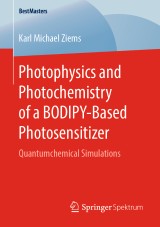Details

Photophysics and Photochemistry of a BODIPY‐Based Photosensitizer
Quantumchemical SimulationsBestMasters
|
53,49 € |
|
| Verlag: | Spektrum Akademischer Verlag bei Elsevier |
| Format: | |
| Veröffentl.: | 24.04.2019 |
| ISBN/EAN: | 9783658261887 |
| Sprache: | englisch |
Dieses eBook enthält ein Wasserzeichen.
Beschreibungen
<div>Karl Michael Ziems investigates a meso-mesityl-2,6-Iodine substituted Boron Dipyrromethene (BODIPY) dye regarding its functionality as photosensitizer in a two-component light-driven hydrogen evolution. The author uses quantum chemical calculations performed at the time-dependent density functional (TDDFT) and multi-state restricted active space perturbation theory through second-order (MS-RASPT2) level of theory. The light-induced processes associated with the formation of the active photosensitizer, i.e., by means of charge separation, as well as the population of undesired degradative pathways are elucidated. Hereby, the two proposed and investigated mechanisms are based on a heavy atom effect of iodine in the (excited) singlet/triplet manifold and preliminary reduction (of the dye) by a sacrificial electron donor and subsequent photoexcitation.</div><div><br></div>
<div>Theoretical Background of Quantum Chemistry.- Computational Details.- Results for Heavy Atom Mechanism.- Results for Chemical Reduction Mechanism.</div><div><br></div>
<div>Karl Michael Ziems obtained his Master of Science in chemistry at the Friedrich Schiller University Jena, and conducted his Master’s thesis in the field of quantum chemistry. Currently, he studies theoretical and computational chemistry at the University of Oxford.</div><div><br></div>
<div>Karl Michael Ziems investigates a meso-mesityl-2,6-Iodine substituted Boron Dipyrromethene (BODIPY) dye regarding its functionality as photosensitizer in a two-component light-driven hydrogen evolution. The author uses quantum chemical calculations performed at the time-dependent density functional (TDDFT) and multi-state restricted active space perturbation theory through second-order (MS-RASPT2) level of theory. The light-induced processes associated with the formation of the active photosensitizer, i.e., by means of charge separation, as well as the population of undesired degradative pathways are elucidated. Hereby, the two proposed and investigated mechanisms are based on a heavy atom effect of iodine in the (excited) singlet/triplet manifold and preliminary reduction (of the dye) by a sacrificial electron donor and subsequent photoexcitation.</div><b><br></b><div><b>Contents</b></div><div><ul><li>Theoretical Background of Quantum Chemistry</li><li>Computational Details</li><li>Results for Heavy Atom Mechanism</li><li>Results for Chemical Reduction Mechanism</li></ul></div><div><b>Target Groups</b><br></div><div>Academics, researchers, and students in the fields of chemistry, especially computational chemistry, and physics<br></div><div><b><br></b></div><div><b>The Author</b><br></div><div><b>Karl Michael Ziems</b> obtained his Master of Science in chemistry at the Friedrich Schiller University Jena, and conducted his Master’s thesis in the field of quantum chemistry. Currently, he studies theoretical and computational chemistry at the University of Oxford.</div><div><br></div>
Publication in the field of natural sciences

















